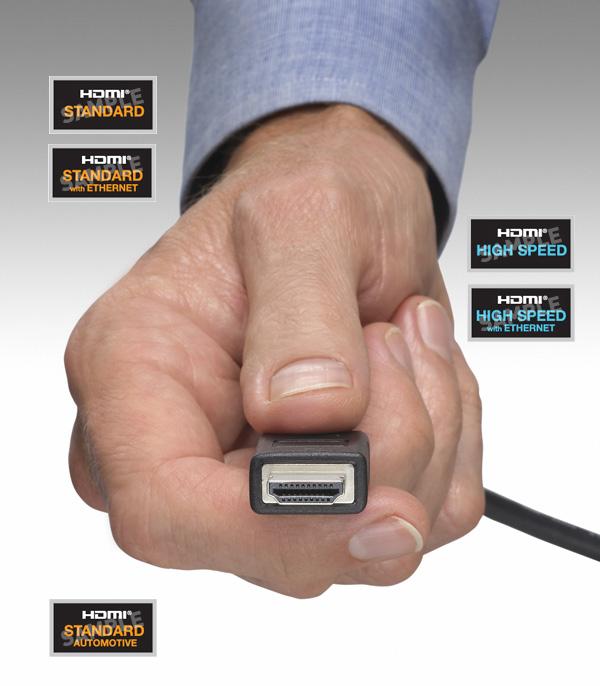Et 2.0, HDMI?

Such is the heartache that always comes with the announcement of any new specification or technology. It’s a common complaint you’ll hear from gear heads, enthusiasts, and even casual electronics consumers. Take Blu-ray, for instance. Despite the fact that all BD players are backwards compatible with DVDs (and CDs), I heard numerous people moan and groan about how they now “had” to upgrade their entire movie collections. Of course, they didn’t have to replace their old DVDs with new BDs; but the kick-buttedness of the new format made them want to rebuy the same movies they’d probably bought two or three times already.
While it didn’t necessarily mean obsolescence each time, it was sure as hell confusing when over ten HDMI Version 1.somethings were released during the first nine years of the standard’s existence. Not only was there a lot of natural confusion – thanks, in part, to a good deal of ineptness on the part of HDMI Licensing - there was an even greater amount of obfuscation (or, at a minimum, a very generous and very self-serving stretching of the truth) about HDMI cables and speed ratings from some of the cable manufacturers themselves.
What many consumers didn’t fully realize was that the HDMI spec is mostly about the connectivity between devices and the supported features. To the chagrin of more than one cable maker, the cables are simply a boring conduit for the data that needs to sluice back and forth. As long as all the pipes are there and they’re big enough to handle the data flow, you can forget about it and move on to more important things. The basic specs for HDMI cables haven’t changed in a while, which is why there was no need to worry about new cables when HDMI 1.4 was announced. HDMI 1.4 only dealt with connectivity, not the insides of the cables or the connectors.
The HDMI Forum finally cut through all the marketing crap and now requires all HDMI cables to be labeled by cable type. There are five types to choose from, and the HDMI Forum says that each is “designed to meet a particular performance standard.” In a sense, though, there are really only two types of HDMI cables: Standard and High Speed. Each one is available in a versions with and without HDMI Ethernet Channel functionality. Then there’s the oddball Standard Automotive HDMI Cable (without Ethernet) that’s a beefier version of the Standard type in order to protect the digital signal traveling through the cable from the large amounts of electrical interference found in an automotive environment. Here’s how the HDMI Forum breaks it down:
Standard HDMI Cable
The Standard HDMI cable is designed to handle most home applications, and is tested to reliably transmit 1080i or 720p video – the HD resolutions that are commonly associated with cable and satellite television, digital broadcast HD, and upscaling DVD players.Standard HDMI Cable with Ethernet
This cable type offers the same baseline performance as the Standard HDMI Cable shown above (720p or 1080i video resolution), plus an additional, dedicated data channel, known as the HDMI Ethernet Channel, for device networking. HDMI Ethernet Channel functionality is only available if both linked devices are HDMI Ethernet Channel-enabled.Standard Automotive HDMI Cable
Supports up to 720p/1080i (does not support HDMI Ethernet Channel). Since an automotive system may be wired with one or more internal relays that can affect signal strength, the Standard Automotive HDMI Cable needs to send a stronger signal than other cables types, so it is tested to higher performance standards.High Speed HDMI Cable
The High Speed HDMI cable is designed and tested to handle video resolutions of 1080p and beyond, including advanced display technologies such as 4K, 3D, and Deep Color. If you are using any of these technologies, or if you are connecting your 1080p display to a 1080p content source, such as a Blu-ray Disc player, this is the recommended cable.High Speed HDMI Cable with Ethernet
This cable type offers the same baseline performance as the High Speed HDMI Cable shown above (1080p video resolution and beyond), plus an additional, dedicated data channel, known as the HDMI Ethernet Channel, for device networking. HDMI Ethernet Channel functionality is only available if both linked devices are HDMI Ethernet Channel-enabled.
Notice there’s no mention of HDMI 2.0 in the above list? That’s because, even with the new spec’s impressive additions – including support for: bandwidth up to 18 Gbps; 4K@50/60, (2160p); up to 32 audio channels, up to 1,536 kHz audio sample frequency, simultaneous delivery of dual video streams on the same screen; simultaneous multi-stream audio for up to four users; support for 21:9 video aspect ratio; dynamic synchronization of video and audio streams; and expanded command and control of devices through CEC extensions – there’s no need for any new cables. As a matter of fact, the HDMI Forum specifically has this to say about cables and connectors with HDMI 2.0:
HDMI 2.0 does not define new cables or new connectors. Current High Speed cables (Category 2 cables) are capable of carrying the increased bandwidth.I think that’s the best part of the new HDMI 2.0 spec. No new cables. It’s like “no new taxes”, except for the fact that cables aren’t a political thing. Well, actually, there are some pretty partisan arguments about HDMI cables regarding price and performance. I’m not going to get into that debate here. I will say this much, however. If you already have High Speed (Category 2) cables in your system, you shouldn’t spend any more than $0.00 for new cables whenever a new HDMI 2.0-equipped piece of gear comes to your house.
That’s the best price for cables you’ll find anywhere.













































